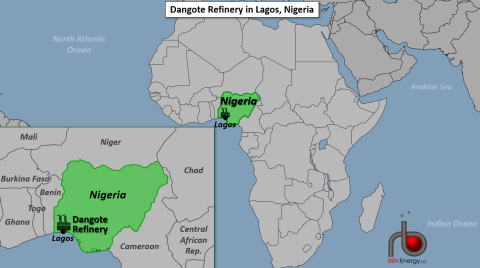The new 650-Mb/d Dangote refinery in Nigeria instantly became Africa’s largest and the world’s seventh-largest by capacity when it finally began processing crude into diesel and aviation fuels in January after years of delays and cost overruns. Long touted as Nigeria’s ticket to ending refined fuels imports by supplying its own markets — with plenty to spare for exports — the Dangote facility could substantially impact trade flows and global supply if it lives up to years of homegrown ballyhoo. In today’s RBN blog, we will examine Dangote’s long road to production, and why we see a slow ramp-up to full capacity through 2026.
In Here I Go Again, Part 1 of this series, we examined the outlook of RBN’s downstream consulting group, Refined Fuels Analytics (RFA), for the Dos Bocas refinery under development by Mexico’s state-owned Petróleos Mexicanos (Pemex), as full-operation dates for it (and Dangote) are important factors in global refining margins and relative tightness of international refined products markets (see We Just Disagree). Both new refineries have significant potential to impact global refined products markets, with claims that they can sharply reduce or eliminate dependence on fuel imports in Mexico and Nigeria, but both also have significant startup and operational risks with uncertain prospects for long-term success.
Figure 1. Dangote Refinery near Lagos, Nigeria. Source: RBN
That said, we are a bit more optimistic about Dangote’s future prospects than those of Dos Bocas, as noted in our most recent Future of Fuels report. Originally proposed in 2013, Dangote (refinery icon in Figure 1) has been touted as facilitating Nigeria’s debut as a refined-fuels-independent country and even a net fuel exporter. While Nigeria is Africa’s leading oil producer with about 1.5 MMb/d of crude and liquids production in 2023 per the Energy Information Administration (EIA), the nation — with a population of about 230 million — relies on imported refined fuels, largely from Europe and to a lesser extent the U.S., because its domestic refining capabilities cannot meet the country’s demand. Nigeria’s total nameplate refining capacity, not including Dangote, is about 445 Mb/d, which could meet most domestic demand if the four refineries operated by the Nigerian National Petroleum Corporation (NNPC), Nigeria’s state-owned oil company, ran reliably. They don’t. Those plants have largely been shut for years, and a string of oil ministers’ predictions of resuming stable operations for a decade or more haven’t come to fruition. We are skeptical of Dangote’s prospects for reaching full capacity this year. RFA expects the plant to ramp up to only an effective 20% of its nameplate capacity on average in 2024, 50% next year and the remaining 30% in 2026 given Dangote’s scale, unusual operations makeup, the country’s iffy track record when it comes to reliable refinery performance, and the operators’ lack of experience.
Join Backstage Pass to Read Full Article









